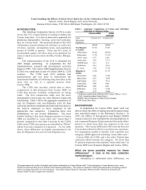
An official website of the United States government
Here’s how you know
Official websites use .gov
A .gov website belongs to an official government organization in the United States.
Secure .gov websites use HTTPS
A lock (
) or https:// means you’ve safely connected to the .gov website. Share sensitive information only on official, secure websites.
-
//
- Census.gov /
- Library /
- Census Working Papers /
- Effects of Interviewer Behavior on Collection of Race Data
Understanding the Effects of Interviewer Behavior on the Collection of Race Data
Understanding the Effects of Interviewer Behavior on the Collection of Race Data
The American Community Survey (ACS) is a new survey the U.S. Census Bureau is testing to replace the Census long form. It is also an innovative approach for producing demographic, housing, social and economic data on a timely basis. The proposed design of the ACS will produce annual estimates for all states, as well as for all cities, counties, metropolitan areas, and population groups of 65,000 or greater. Three and five years of accumulated sample will allow data to be produced for areas as small as census tracts (Griffin, Fischer, Morgan, 2001).
Full implementation of the ACS is scheduled for 2003 budget permitting. In preparation for full implementation, research and development activities began in 1996. The Census 2000 Supplementary Survey (C2SS) was conducted as part of Census 2000 in 1,203 counties. The C2SS used ACS methods and questionnaires and was done to demonstrate the operational feasibility of collecting long form data at the same time as, but in a separate process from, Census 2000.
The C2SS also provides critical data to allow comparisons to data produced from Census 2000. As C2SS data become available, comparisons are being made. The first comparisons made were the basic demographics such as age, sex, race, Hispanic origin, and relationship. Table 1 shows the aggregate comparison of race for Hispanics and non-Hispanics after all data collection had been completed and edits had been done to the write-in responses to move responses to the appropriate race categories. Comparing these race distributions, we see several differences. The most notable finding is that more Hispanic persons in Census 2000 are classified as “some other race” (more than 5 percent compared to less than 4 percent in the C2SS) while in the C2SS more persons are classified as “White” (about 8 percent compared to 6 percent). As this table shows, these differences are highly concentrated in the data for Hispanics, but exist for non-Hispanics too.
Others in Series
Working Paper
Working Paper
Working Paper
Share
Some content on this site is available in several different electronic formats. Some of the files may require a plug-in or additional software to view.
 Yes
Yes
 No
NoComments or suggestions?


Top

